Safe Administration of Medications: Clinical Trials, TGA Regulation, Pharmacokinetics, Medication Errors and Swiss Cheese Model
VerifiedAdded on 2023/06/08
|15
|3241
|482
AI Summary
This article covers the safe administration of medications through clinical trials, TGA regulation, pharmacokinetics, medication errors and Swiss cheese model. It explains the roles and responsibilities of nurses, doctors and pharmacists in medication administration. It also discusses the factors responsible for medication errors.
Contribute Materials
Your contribution can guide someone’s learning journey. Share your
documents today.
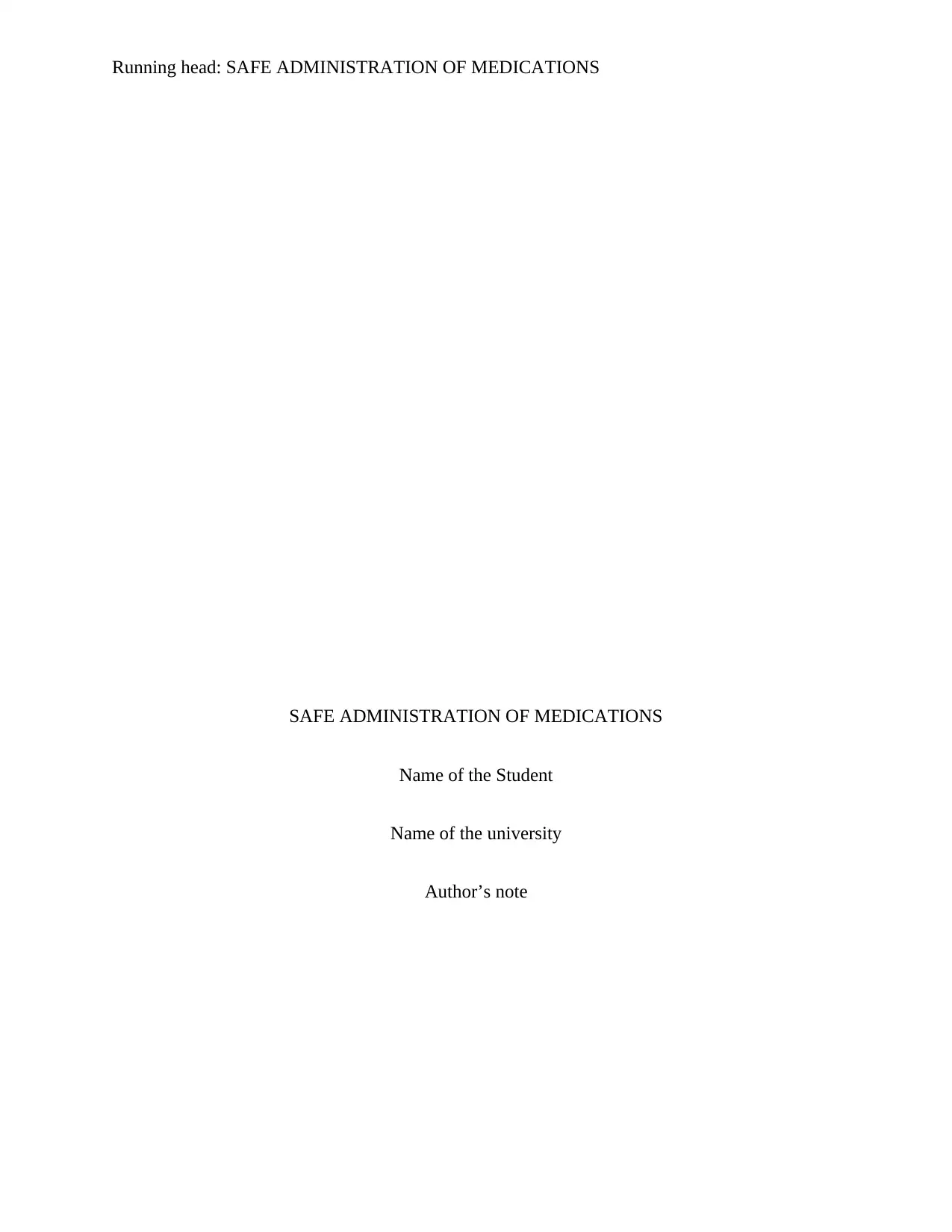
Running head: SAFE ADMINISTRATION OF MEDICATIONS
SAFE ADMINISTRATION OF MEDICATIONS
Name of the Student
Name of the university
Author’s note
SAFE ADMINISTRATION OF MEDICATIONS
Name of the Student
Name of the university
Author’s note
Secure Best Marks with AI Grader
Need help grading? Try our AI Grader for instant feedback on your assignments.
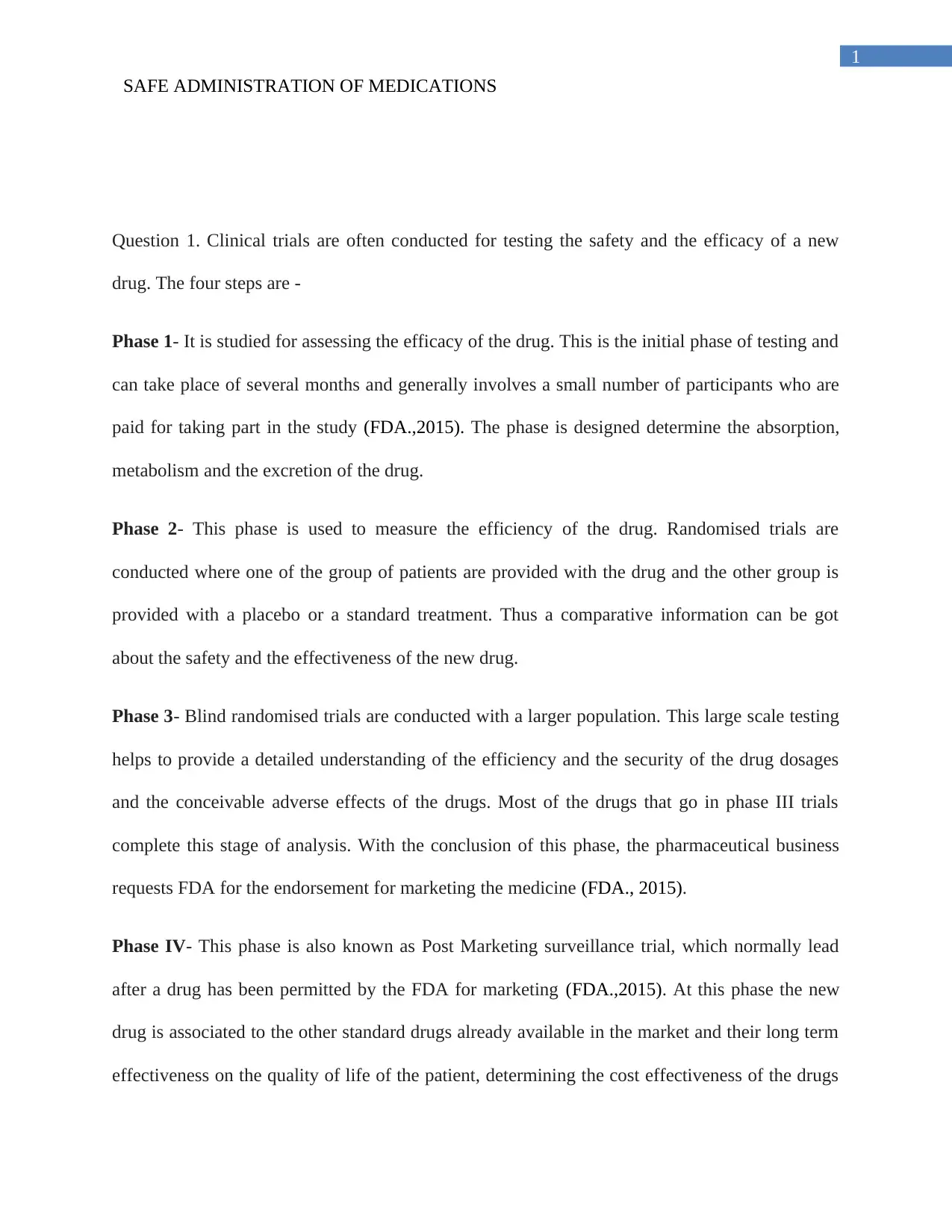
1
SAFE ADMINISTRATION OF MEDICATIONS
Question 1. Clinical trials are often conducted for testing the safety and the efficacy of a new
drug. The four steps are -
Phase 1- It is studied for assessing the efficacy of the drug. This is the initial phase of testing and
can take place of several months and generally involves a small number of participants who are
paid for taking part in the study (FDA.,2015). The phase is designed determine the absorption,
metabolism and the excretion of the drug.
Phase 2- This phase is used to measure the efficiency of the drug. Randomised trials are
conducted where one of the group of patients are provided with the drug and the other group is
provided with a placebo or a standard treatment. Thus a comparative information can be got
about the safety and the effectiveness of the new drug.
Phase 3- Blind randomised trials are conducted with a larger population. This large scale testing
helps to provide a detailed understanding of the efficiency and the security of the drug dosages
and the conceivable adverse effects of the drugs. Most of the drugs that go in phase III trials
complete this stage of analysis. With the conclusion of this phase, the pharmaceutical business
requests FDA for the endorsement for marketing the medicine (FDA., 2015).
Phase IV- This phase is also known as Post Marketing surveillance trial, which normally lead
after a drug has been permitted by the FDA for marketing (FDA.,2015). At this phase the new
drug is associated to the other standard drugs already available in the market and their long term
effectiveness on the quality of life of the patient, determining the cost effectiveness of the drugs
SAFE ADMINISTRATION OF MEDICATIONS
Question 1. Clinical trials are often conducted for testing the safety and the efficacy of a new
drug. The four steps are -
Phase 1- It is studied for assessing the efficacy of the drug. This is the initial phase of testing and
can take place of several months and generally involves a small number of participants who are
paid for taking part in the study (FDA.,2015). The phase is designed determine the absorption,
metabolism and the excretion of the drug.
Phase 2- This phase is used to measure the efficiency of the drug. Randomised trials are
conducted where one of the group of patients are provided with the drug and the other group is
provided with a placebo or a standard treatment. Thus a comparative information can be got
about the safety and the effectiveness of the new drug.
Phase 3- Blind randomised trials are conducted with a larger population. This large scale testing
helps to provide a detailed understanding of the efficiency and the security of the drug dosages
and the conceivable adverse effects of the drugs. Most of the drugs that go in phase III trials
complete this stage of analysis. With the conclusion of this phase, the pharmaceutical business
requests FDA for the endorsement for marketing the medicine (FDA., 2015).
Phase IV- This phase is also known as Post Marketing surveillance trial, which normally lead
after a drug has been permitted by the FDA for marketing (FDA.,2015). At this phase the new
drug is associated to the other standard drugs already available in the market and their long term
effectiveness on the quality of life of the patient, determining the cost effectiveness of the drugs
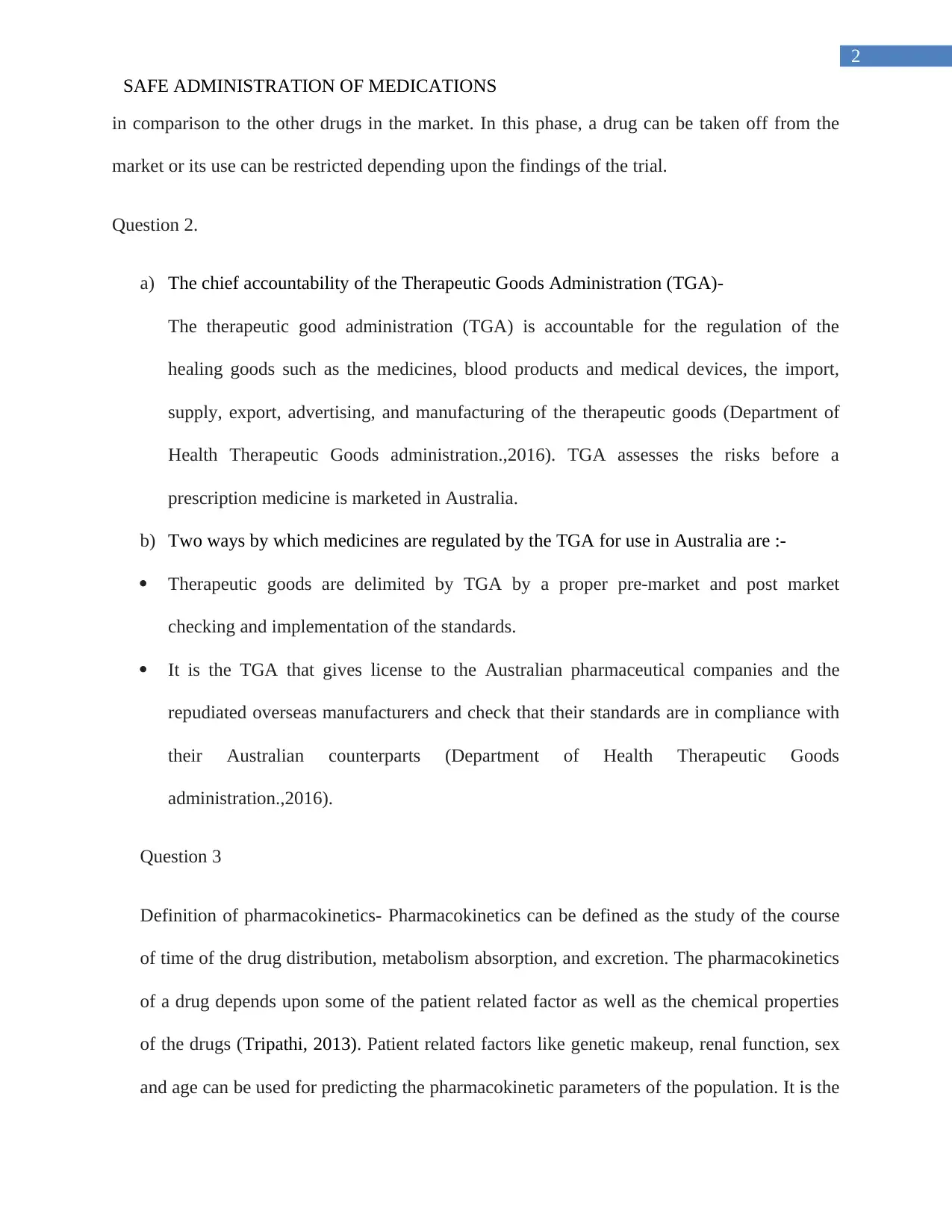
2
SAFE ADMINISTRATION OF MEDICATIONS
in comparison to the other drugs in the market. In this phase, a drug can be taken off from the
market or its use can be restricted depending upon the findings of the trial.
Question 2.
a) The chief accountability of the Therapeutic Goods Administration (TGA)-
The therapeutic good administration (TGA) is accountable for the regulation of the
healing goods such as the medicines, blood products and medical devices, the import,
supply, export, advertising, and manufacturing of the therapeutic goods (Department of
Health Therapeutic Goods administration.,2016). TGA assesses the risks before a
prescription medicine is marketed in Australia.
b) Two ways by which medicines are regulated by the TGA for use in Australia are :-
Therapeutic goods are delimited by TGA by a proper pre-market and post market
checking and implementation of the standards.
It is the TGA that gives license to the Australian pharmaceutical companies and the
repudiated overseas manufacturers and check that their standards are in compliance with
their Australian counterparts (Department of Health Therapeutic Goods
administration.,2016).
Question 3
Definition of pharmacokinetics- Pharmacokinetics can be defined as the study of the course
of time of the drug distribution, metabolism absorption, and excretion. The pharmacokinetics
of a drug depends upon some of the patient related factor as well as the chemical properties
of the drugs (Tripathi, 2013). Patient related factors like genetic makeup, renal function, sex
and age can be used for predicting the pharmacokinetic parameters of the population. It is the
SAFE ADMINISTRATION OF MEDICATIONS
in comparison to the other drugs in the market. In this phase, a drug can be taken off from the
market or its use can be restricted depending upon the findings of the trial.
Question 2.
a) The chief accountability of the Therapeutic Goods Administration (TGA)-
The therapeutic good administration (TGA) is accountable for the regulation of the
healing goods such as the medicines, blood products and medical devices, the import,
supply, export, advertising, and manufacturing of the therapeutic goods (Department of
Health Therapeutic Goods administration.,2016). TGA assesses the risks before a
prescription medicine is marketed in Australia.
b) Two ways by which medicines are regulated by the TGA for use in Australia are :-
Therapeutic goods are delimited by TGA by a proper pre-market and post market
checking and implementation of the standards.
It is the TGA that gives license to the Australian pharmaceutical companies and the
repudiated overseas manufacturers and check that their standards are in compliance with
their Australian counterparts (Department of Health Therapeutic Goods
administration.,2016).
Question 3
Definition of pharmacokinetics- Pharmacokinetics can be defined as the study of the course
of time of the drug distribution, metabolism absorption, and excretion. The pharmacokinetics
of a drug depends upon some of the patient related factor as well as the chemical properties
of the drugs (Tripathi, 2013). Patient related factors like genetic makeup, renal function, sex
and age can be used for predicting the pharmacokinetic parameters of the population. It is the
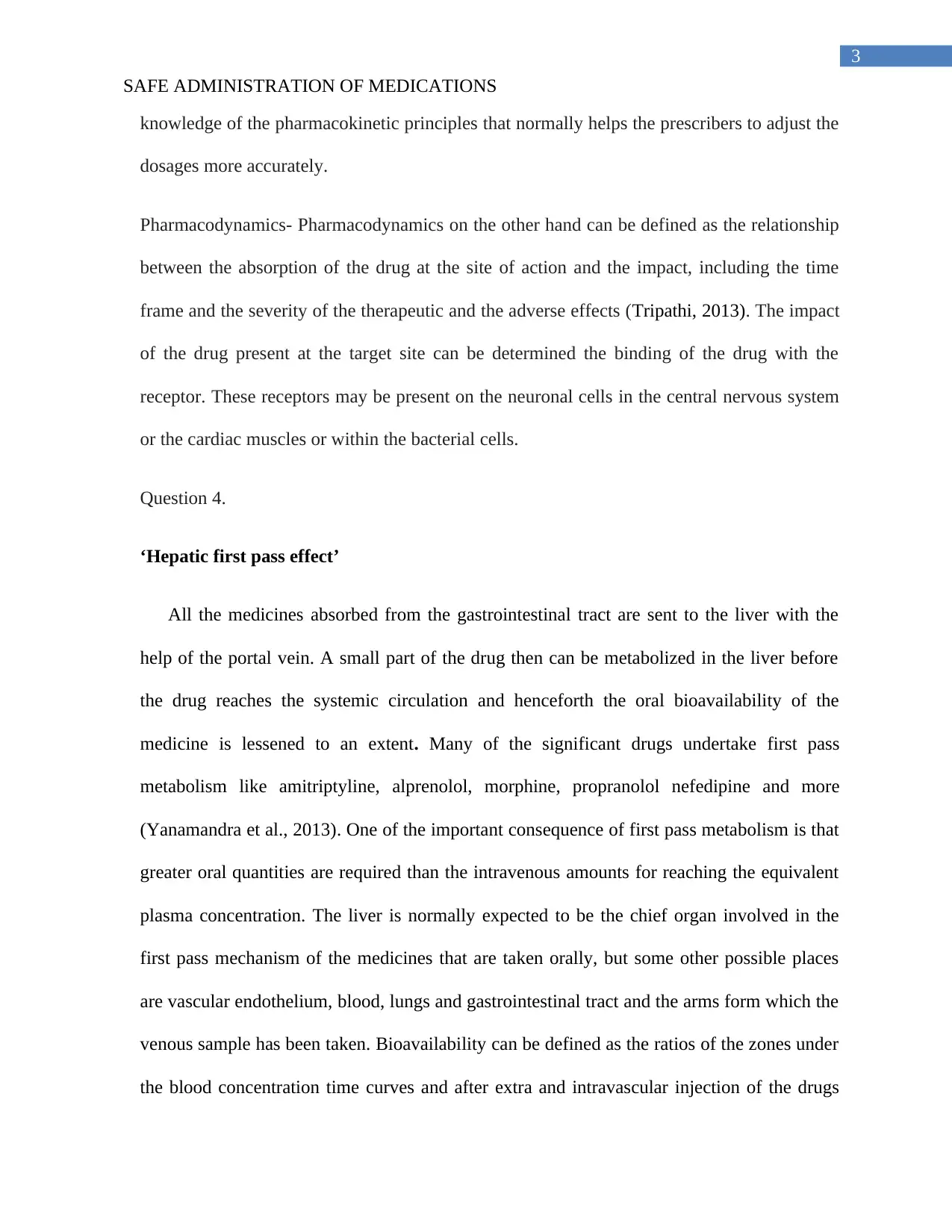
3
SAFE ADMINISTRATION OF MEDICATIONS
knowledge of the pharmacokinetic principles that normally helps the prescribers to adjust the
dosages more accurately.
Pharmacodynamics- Pharmacodynamics on the other hand can be defined as the relationship
between the absorption of the drug at the site of action and the impact, including the time
frame and the severity of the therapeutic and the adverse effects (Tripathi, 2013). The impact
of the drug present at the target site can be determined the binding of the drug with the
receptor. These receptors may be present on the neuronal cells in the central nervous system
or the cardiac muscles or within the bacterial cells.
Question 4.
‘Hepatic first pass effect’
All the medicines absorbed from the gastrointestinal tract are sent to the liver with the
help of the portal vein. A small part of the drug then can be metabolized in the liver before
the drug reaches the systemic circulation and henceforth the oral bioavailability of the
medicine is lessened to an extent. Many of the significant drugs undertake first pass
metabolism like amitriptyline, alprenolol, morphine, propranolol nefedipine and more
(Yanamandra et al., 2013). One of the important consequence of first pass metabolism is that
greater oral quantities are required than the intravenous amounts for reaching the equivalent
plasma concentration. The liver is normally expected to be the chief organ involved in the
first pass mechanism of the medicines that are taken orally, but some other possible places
are vascular endothelium, blood, lungs and gastrointestinal tract and the arms form which the
venous sample has been taken. Bioavailability can be defined as the ratios of the zones under
the blood concentration time curves and after extra and intravascular injection of the drugs
SAFE ADMINISTRATION OF MEDICATIONS
knowledge of the pharmacokinetic principles that normally helps the prescribers to adjust the
dosages more accurately.
Pharmacodynamics- Pharmacodynamics on the other hand can be defined as the relationship
between the absorption of the drug at the site of action and the impact, including the time
frame and the severity of the therapeutic and the adverse effects (Tripathi, 2013). The impact
of the drug present at the target site can be determined the binding of the drug with the
receptor. These receptors may be present on the neuronal cells in the central nervous system
or the cardiac muscles or within the bacterial cells.
Question 4.
‘Hepatic first pass effect’
All the medicines absorbed from the gastrointestinal tract are sent to the liver with the
help of the portal vein. A small part of the drug then can be metabolized in the liver before
the drug reaches the systemic circulation and henceforth the oral bioavailability of the
medicine is lessened to an extent. Many of the significant drugs undertake first pass
metabolism like amitriptyline, alprenolol, morphine, propranolol nefedipine and more
(Yanamandra et al., 2013). One of the important consequence of first pass metabolism is that
greater oral quantities are required than the intravenous amounts for reaching the equivalent
plasma concentration. The liver is normally expected to be the chief organ involved in the
first pass mechanism of the medicines that are taken orally, but some other possible places
are vascular endothelium, blood, lungs and gastrointestinal tract and the arms form which the
venous sample has been taken. Bioavailability can be defined as the ratios of the zones under
the blood concentration time curves and after extra and intravascular injection of the drugs
Secure Best Marks with AI Grader
Need help grading? Try our AI Grader for instant feedback on your assignments.
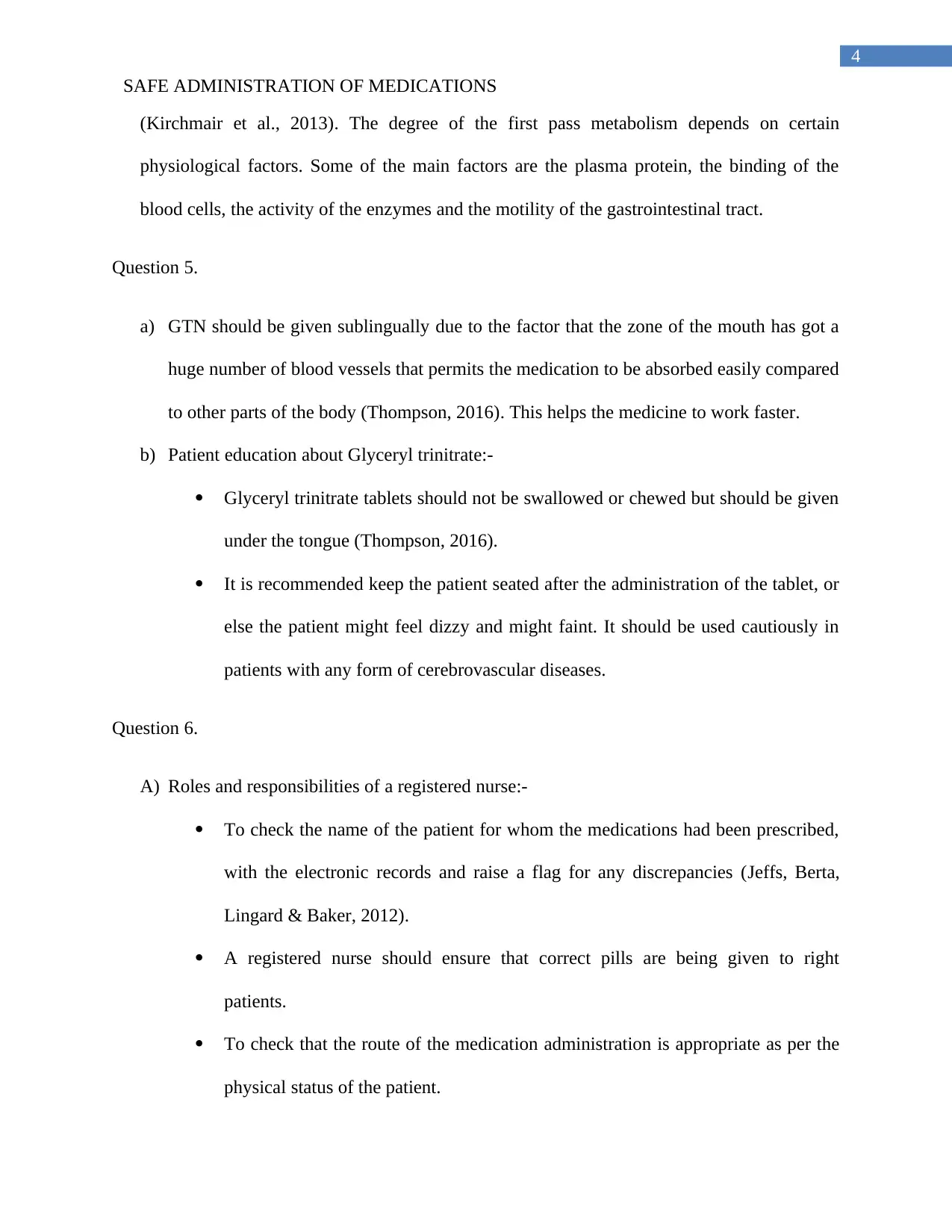
4
SAFE ADMINISTRATION OF MEDICATIONS
(Kirchmair et al., 2013). The degree of the first pass metabolism depends on certain
physiological factors. Some of the main factors are the plasma protein, the binding of the
blood cells, the activity of the enzymes and the motility of the gastrointestinal tract.
Question 5.
a) GTN should be given sublingually due to the factor that the zone of the mouth has got a
huge number of blood vessels that permits the medication to be absorbed easily compared
to other parts of the body (Thompson, 2016). This helps the medicine to work faster.
b) Patient education about Glyceryl trinitrate:-
Glyceryl trinitrate tablets should not be swallowed or chewed but should be given
under the tongue (Thompson, 2016).
It is recommended keep the patient seated after the administration of the tablet, or
else the patient might feel dizzy and might faint. It should be used cautiously in
patients with any form of cerebrovascular diseases.
Question 6.
A) Roles and responsibilities of a registered nurse:-
To check the name of the patient for whom the medications had been prescribed,
with the electronic records and raise a flag for any discrepancies (Jeffs, Berta,
Lingard & Baker, 2012).
A registered nurse should ensure that correct pills are being given to right
patients.
To check that the route of the medication administration is appropriate as per the
physical status of the patient.
SAFE ADMINISTRATION OF MEDICATIONS
(Kirchmair et al., 2013). The degree of the first pass metabolism depends on certain
physiological factors. Some of the main factors are the plasma protein, the binding of the
blood cells, the activity of the enzymes and the motility of the gastrointestinal tract.
Question 5.
a) GTN should be given sublingually due to the factor that the zone of the mouth has got a
huge number of blood vessels that permits the medication to be absorbed easily compared
to other parts of the body (Thompson, 2016). This helps the medicine to work faster.
b) Patient education about Glyceryl trinitrate:-
Glyceryl trinitrate tablets should not be swallowed or chewed but should be given
under the tongue (Thompson, 2016).
It is recommended keep the patient seated after the administration of the tablet, or
else the patient might feel dizzy and might faint. It should be used cautiously in
patients with any form of cerebrovascular diseases.
Question 6.
A) Roles and responsibilities of a registered nurse:-
To check the name of the patient for whom the medications had been prescribed,
with the electronic records and raise a flag for any discrepancies (Jeffs, Berta,
Lingard & Baker, 2012).
A registered nurse should ensure that correct pills are being given to right
patients.
To check that the route of the medication administration is appropriate as per the
physical status of the patient.

5
SAFE ADMINISTRATION OF MEDICATIONS
To go through the patient medical history to look for any history of adverse drug
reactions or allergic to specific medications.
To cross check the medication dosages before the administration (Jeffs, Berta,
Lingard & Baker, 2012).
To maintain the timing of administration of the medicines. Most of the
intravenous medications are added slowly.
B) Roles and tasks of a doctor in the safe use of medicines:-
Doctors play a major role in the prescription of the correct medications to correct
patients depending upon the clinical condition of the patient and past medical
history (Ehsani et al., 2013).
The doctor is accountable to look at all the adverse events related to the drug
design and report.
He is accountable to check that correct dosages of medicine has been
administered to the patients.
The doctor is responsible for supervising the reason is the patient suffers from any
kind of adverse events.
A doctor is responsible for the change or the discontinuation of the medications.
C) Roles and responsibilities of a pharmacist in the safe use of medications:-
It the role of the pharmacist to check that all the order are correctly placed and
correct medicines are dispensed to correct patients.
Arrangement and safe storage and delivery of the medical products.
Counseling the public, coming for over the counter medications, for minor
ailments and informing them about any side effects.
SAFE ADMINISTRATION OF MEDICATIONS
To go through the patient medical history to look for any history of adverse drug
reactions or allergic to specific medications.
To cross check the medication dosages before the administration (Jeffs, Berta,
Lingard & Baker, 2012).
To maintain the timing of administration of the medicines. Most of the
intravenous medications are added slowly.
B) Roles and tasks of a doctor in the safe use of medicines:-
Doctors play a major role in the prescription of the correct medications to correct
patients depending upon the clinical condition of the patient and past medical
history (Ehsani et al., 2013).
The doctor is accountable to look at all the adverse events related to the drug
design and report.
He is accountable to check that correct dosages of medicine has been
administered to the patients.
The doctor is responsible for supervising the reason is the patient suffers from any
kind of adverse events.
A doctor is responsible for the change or the discontinuation of the medications.
C) Roles and responsibilities of a pharmacist in the safe use of medications:-
It the role of the pharmacist to check that all the order are correctly placed and
correct medicines are dispensed to correct patients.
Arrangement and safe storage and delivery of the medical products.
Counseling the public, coming for over the counter medications, for minor
ailments and informing them about any side effects.

6
SAFE ADMINISTRATION OF MEDICATIONS
Supervising the dosages of the medication and checking that all the stocks are
updated and within the expiry date, remaining updated with the current pharmacy
practice.
Community pharmacists are accountable to liaise with the doctors regarding the
prescription.
Question 7
FIVE (5) different kinds of medication mistake AND a possible cause for each:-
The prescribing errors- This is caused, when the selection of the drug is incorrect based
on the current and past health status of the patient.
Causes- This mistake can be caused by incomplete patient information or due to the negligence
of the patient.
Improper administration error- This kind of error can occur if the medication is
administered intravenously instead of orally.
Causes- This can be caused if the registered nurse lacks appropriate knowledge regarding the
pathology of the drug, the contraindications and the side effects.
Wrong dose errors- This type of error occurs when correct dose is prescribed but wrong
dose is administered.
Causes- This type of medication error mainly occurs due to the negligence of the nurse.
Distraction or excessive workload may give rise to such kind of medication errors. Improper
patient chart or documentation is one of the primary reasons for these kinds of medication
errors.
SAFE ADMINISTRATION OF MEDICATIONS
Supervising the dosages of the medication and checking that all the stocks are
updated and within the expiry date, remaining updated with the current pharmacy
practice.
Community pharmacists are accountable to liaise with the doctors regarding the
prescription.
Question 7
FIVE (5) different kinds of medication mistake AND a possible cause for each:-
The prescribing errors- This is caused, when the selection of the drug is incorrect based
on the current and past health status of the patient.
Causes- This mistake can be caused by incomplete patient information or due to the negligence
of the patient.
Improper administration error- This kind of error can occur if the medication is
administered intravenously instead of orally.
Causes- This can be caused if the registered nurse lacks appropriate knowledge regarding the
pathology of the drug, the contraindications and the side effects.
Wrong dose errors- This type of error occurs when correct dose is prescribed but wrong
dose is administered.
Causes- This type of medication error mainly occurs due to the negligence of the nurse.
Distraction or excessive workload may give rise to such kind of medication errors. Improper
patient chart or documentation is one of the primary reasons for these kinds of medication
errors.
Paraphrase This Document
Need a fresh take? Get an instant paraphrase of this document with our AI Paraphraser
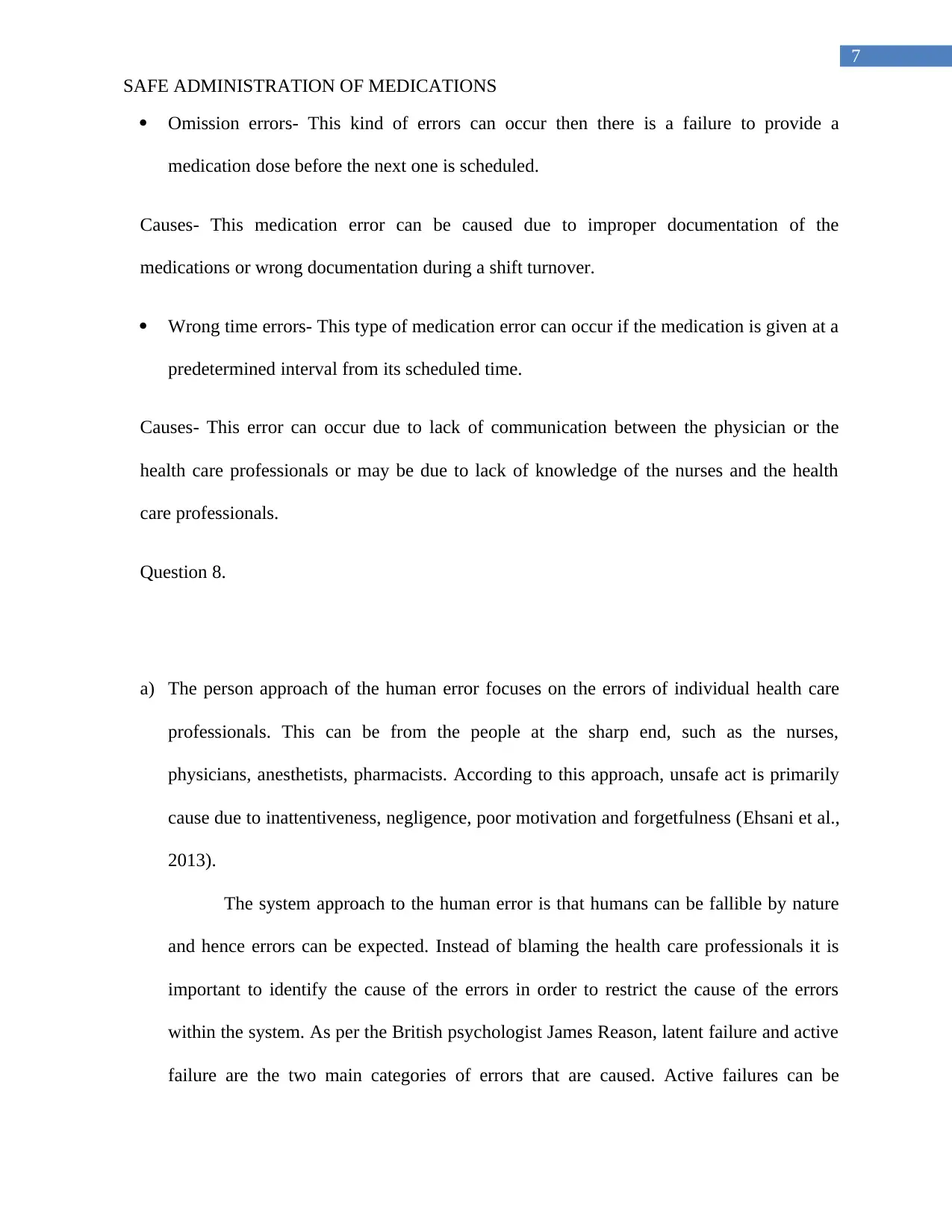
7
SAFE ADMINISTRATION OF MEDICATIONS
Omission errors- This kind of errors can occur then there is a failure to provide a
medication dose before the next one is scheduled.
Causes- This medication error can be caused due to improper documentation of the
medications or wrong documentation during a shift turnover.
Wrong time errors- This type of medication error can occur if the medication is given at a
predetermined interval from its scheduled time.
Causes- This error can occur due to lack of communication between the physician or the
health care professionals or may be due to lack of knowledge of the nurses and the health
care professionals.
Question 8.
a) The person approach of the human error focuses on the errors of individual health care
professionals. This can be from the people at the sharp end, such as the nurses,
physicians, anesthetists, pharmacists. According to this approach, unsafe act is primarily
cause due to inattentiveness, negligence, poor motivation and forgetfulness (Ehsani et al.,
2013).
The system approach to the human error is that humans can be fallible by nature
and hence errors can be expected. Instead of blaming the health care professionals it is
important to identify the cause of the errors in order to restrict the cause of the errors
within the system. As per the British psychologist James Reason, latent failure and active
failure are the two main categories of errors that are caused. Active failures can be
SAFE ADMINISTRATION OF MEDICATIONS
Omission errors- This kind of errors can occur then there is a failure to provide a
medication dose before the next one is scheduled.
Causes- This medication error can be caused due to improper documentation of the
medications or wrong documentation during a shift turnover.
Wrong time errors- This type of medication error can occur if the medication is given at a
predetermined interval from its scheduled time.
Causes- This error can occur due to lack of communication between the physician or the
health care professionals or may be due to lack of knowledge of the nurses and the health
care professionals.
Question 8.
a) The person approach of the human error focuses on the errors of individual health care
professionals. This can be from the people at the sharp end, such as the nurses,
physicians, anesthetists, pharmacists. According to this approach, unsafe act is primarily
cause due to inattentiveness, negligence, poor motivation and forgetfulness (Ehsani et al.,
2013).
The system approach to the human error is that humans can be fallible by nature
and hence errors can be expected. Instead of blaming the health care professionals it is
important to identify the cause of the errors in order to restrict the cause of the errors
within the system. As per the British psychologist James Reason, latent failure and active
failure are the two main categories of errors that are caused. Active failures can be
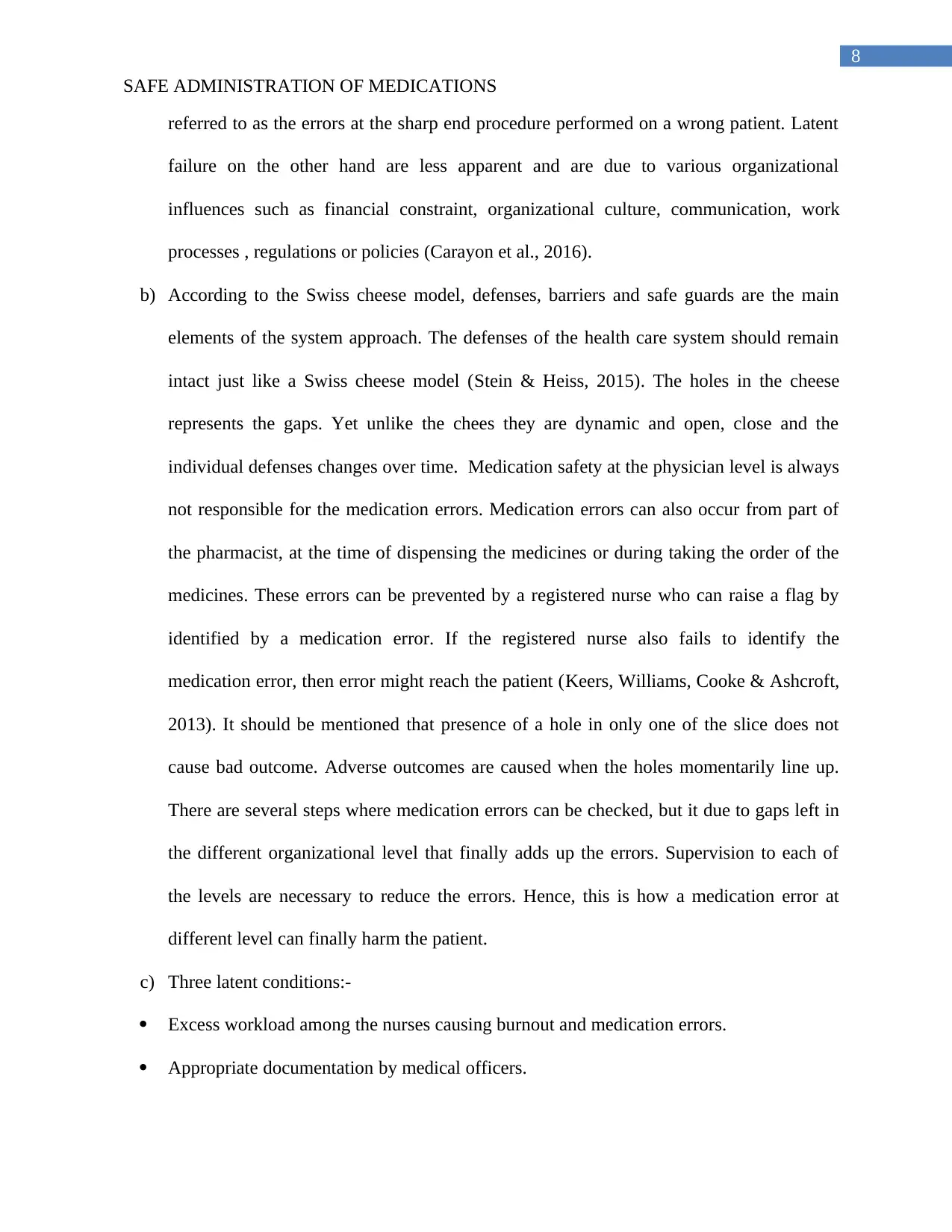
8
SAFE ADMINISTRATION OF MEDICATIONS
referred to as the errors at the sharp end procedure performed on a wrong patient. Latent
failure on the other hand are less apparent and are due to various organizational
influences such as financial constraint, organizational culture, communication, work
processes , regulations or policies (Carayon et al., 2016).
b) According to the Swiss cheese model, defenses, barriers and safe guards are the main
elements of the system approach. The defenses of the health care system should remain
intact just like a Swiss cheese model (Stein & Heiss, 2015). The holes in the cheese
represents the gaps. Yet unlike the chees they are dynamic and open, close and the
individual defenses changes over time. Medication safety at the physician level is always
not responsible for the medication errors. Medication errors can also occur from part of
the pharmacist, at the time of dispensing the medicines or during taking the order of the
medicines. These errors can be prevented by a registered nurse who can raise a flag by
identified by a medication error. If the registered nurse also fails to identify the
medication error, then error might reach the patient (Keers, Williams, Cooke & Ashcroft,
2013). It should be mentioned that presence of a hole in only one of the slice does not
cause bad outcome. Adverse outcomes are caused when the holes momentarily line up.
There are several steps where medication errors can be checked, but it due to gaps left in
the different organizational level that finally adds up the errors. Supervision to each of
the levels are necessary to reduce the errors. Hence, this is how a medication error at
different level can finally harm the patient.
c) Three latent conditions:-
Excess workload among the nurses causing burnout and medication errors.
Appropriate documentation by medical officers.
SAFE ADMINISTRATION OF MEDICATIONS
referred to as the errors at the sharp end procedure performed on a wrong patient. Latent
failure on the other hand are less apparent and are due to various organizational
influences such as financial constraint, organizational culture, communication, work
processes , regulations or policies (Carayon et al., 2016).
b) According to the Swiss cheese model, defenses, barriers and safe guards are the main
elements of the system approach. The defenses of the health care system should remain
intact just like a Swiss cheese model (Stein & Heiss, 2015). The holes in the cheese
represents the gaps. Yet unlike the chees they are dynamic and open, close and the
individual defenses changes over time. Medication safety at the physician level is always
not responsible for the medication errors. Medication errors can also occur from part of
the pharmacist, at the time of dispensing the medicines or during taking the order of the
medicines. These errors can be prevented by a registered nurse who can raise a flag by
identified by a medication error. If the registered nurse also fails to identify the
medication error, then error might reach the patient (Keers, Williams, Cooke & Ashcroft,
2013). It should be mentioned that presence of a hole in only one of the slice does not
cause bad outcome. Adverse outcomes are caused when the holes momentarily line up.
There are several steps where medication errors can be checked, but it due to gaps left in
the different organizational level that finally adds up the errors. Supervision to each of
the levels are necessary to reduce the errors. Hence, this is how a medication error at
different level can finally harm the patient.
c) Three latent conditions:-
Excess workload among the nurses causing burnout and medication errors.
Appropriate documentation by medical officers.

9
SAFE ADMINISTRATION OF MEDICATIONS
Appointment of incompetent nurses by the organization who have less knowledge
regarding medication administration.
Three active failures:-
Incorrect prescription of medications
Incorrect dosage of medicine applied by the nurses.
Incorrect order taken by the pharmacist.
Question 9.
Five factors that are responsible for medication errors are as follows:-
Distraction in the nurses- Nurses might lose mindfulness or get distracted that can
give rise to medication errors. Such as, a nurse can read diazepam to be diltiazem
(Unver, Tastan & Akbayrak, 2012).
Cause- This can be caused due to excessive workload of the nurses, where a single nurse
have to attend several patients.
Lack of knowledge- Nurses without any complete knowledge of pathology of the
medications or dosage or contraindications may cause medication error.
Causes- Incompetent or unaccredited nurses recruited by the organizations may give rise t
medication errors.
Incomplete patient information
SAFE ADMINISTRATION OF MEDICATIONS
Appointment of incompetent nurses by the organization who have less knowledge
regarding medication administration.
Three active failures:-
Incorrect prescription of medications
Incorrect dosage of medicine applied by the nurses.
Incorrect order taken by the pharmacist.
Question 9.
Five factors that are responsible for medication errors are as follows:-
Distraction in the nurses- Nurses might lose mindfulness or get distracted that can
give rise to medication errors. Such as, a nurse can read diazepam to be diltiazem
(Unver, Tastan & Akbayrak, 2012).
Cause- This can be caused due to excessive workload of the nurses, where a single nurse
have to attend several patients.
Lack of knowledge- Nurses without any complete knowledge of pathology of the
medications or dosage or contraindications may cause medication error.
Causes- Incompetent or unaccredited nurses recruited by the organizations may give rise t
medication errors.
Incomplete patient information
Secure Best Marks with AI Grader
Need help grading? Try our AI Grader for instant feedback on your assignments.
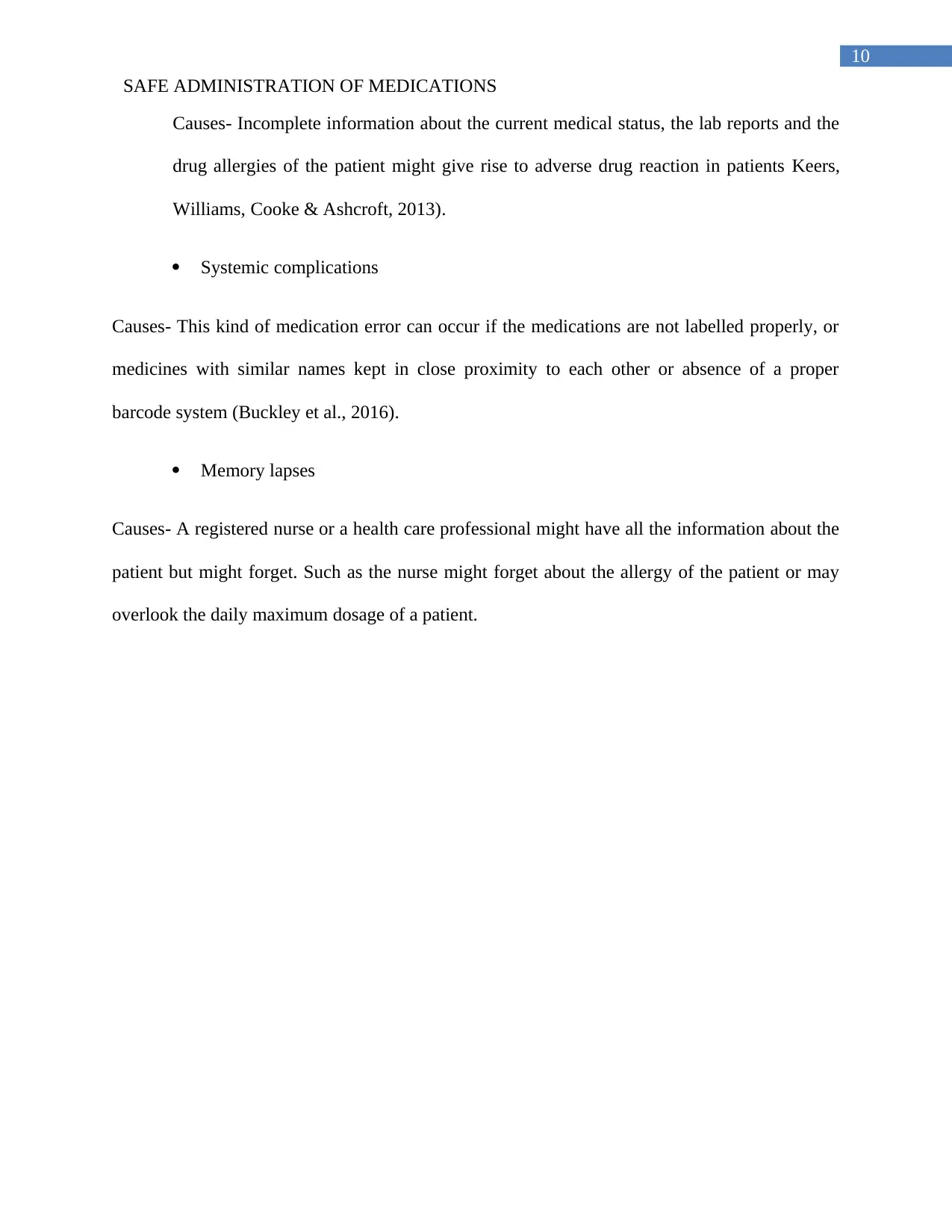
10
SAFE ADMINISTRATION OF MEDICATIONS
Causes- Incomplete information about the current medical status, the lab reports and the
drug allergies of the patient might give rise to adverse drug reaction in patients Keers,
Williams, Cooke & Ashcroft, 2013).
Systemic complications
Causes- This kind of medication error can occur if the medications are not labelled properly, or
medicines with similar names kept in close proximity to each other or absence of a proper
barcode system (Buckley et al., 2016).
Memory lapses
Causes- A registered nurse or a health care professional might have all the information about the
patient but might forget. Such as the nurse might forget about the allergy of the patient or may
overlook the daily maximum dosage of a patient.
SAFE ADMINISTRATION OF MEDICATIONS
Causes- Incomplete information about the current medical status, the lab reports and the
drug allergies of the patient might give rise to adverse drug reaction in patients Keers,
Williams, Cooke & Ashcroft, 2013).
Systemic complications
Causes- This kind of medication error can occur if the medications are not labelled properly, or
medicines with similar names kept in close proximity to each other or absence of a proper
barcode system (Buckley et al., 2016).
Memory lapses
Causes- A registered nurse or a health care professional might have all the information about the
patient but might forget. Such as the nurse might forget about the allergy of the patient or may
overlook the daily maximum dosage of a patient.
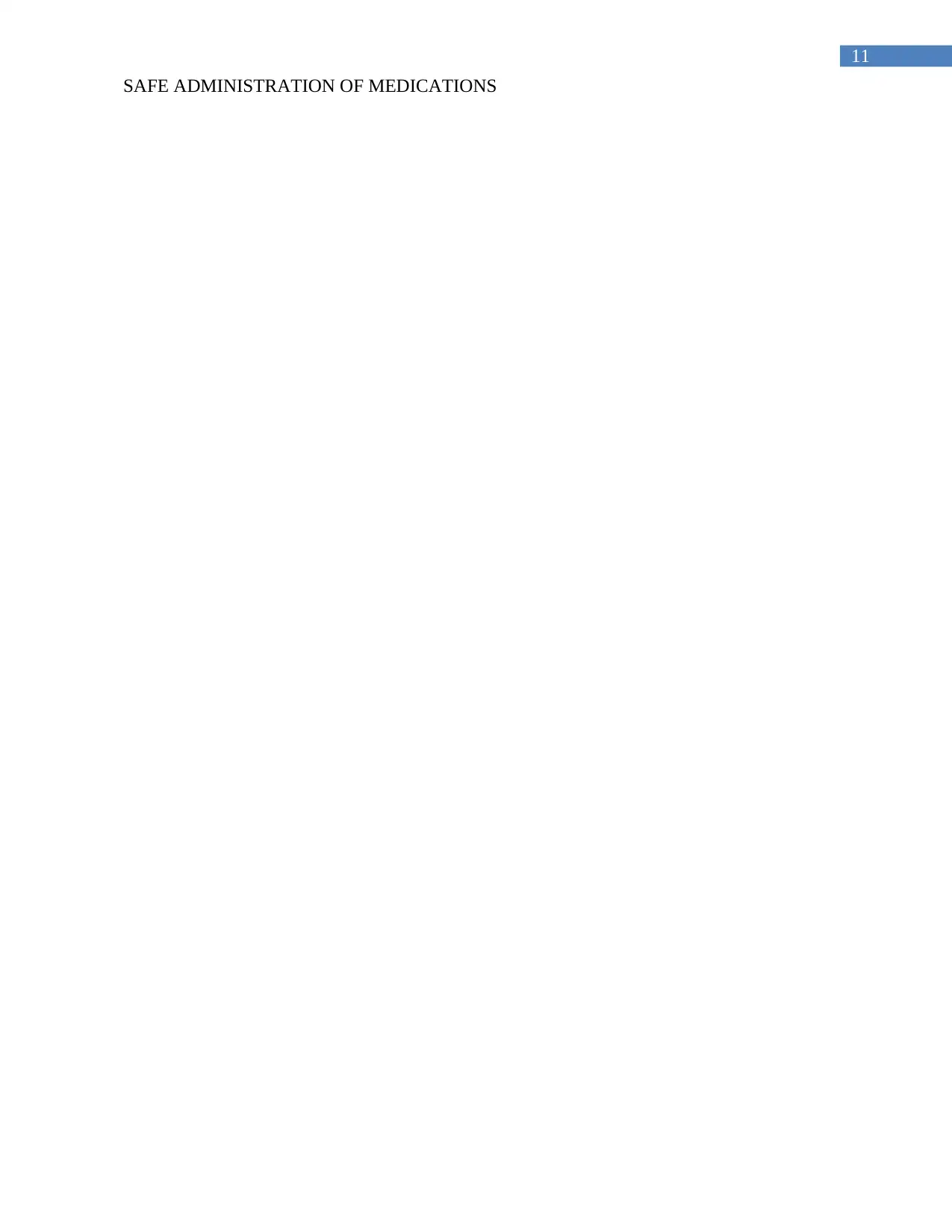
11
SAFE ADMINISTRATION OF MEDICATIONS
SAFE ADMINISTRATION OF MEDICATIONS
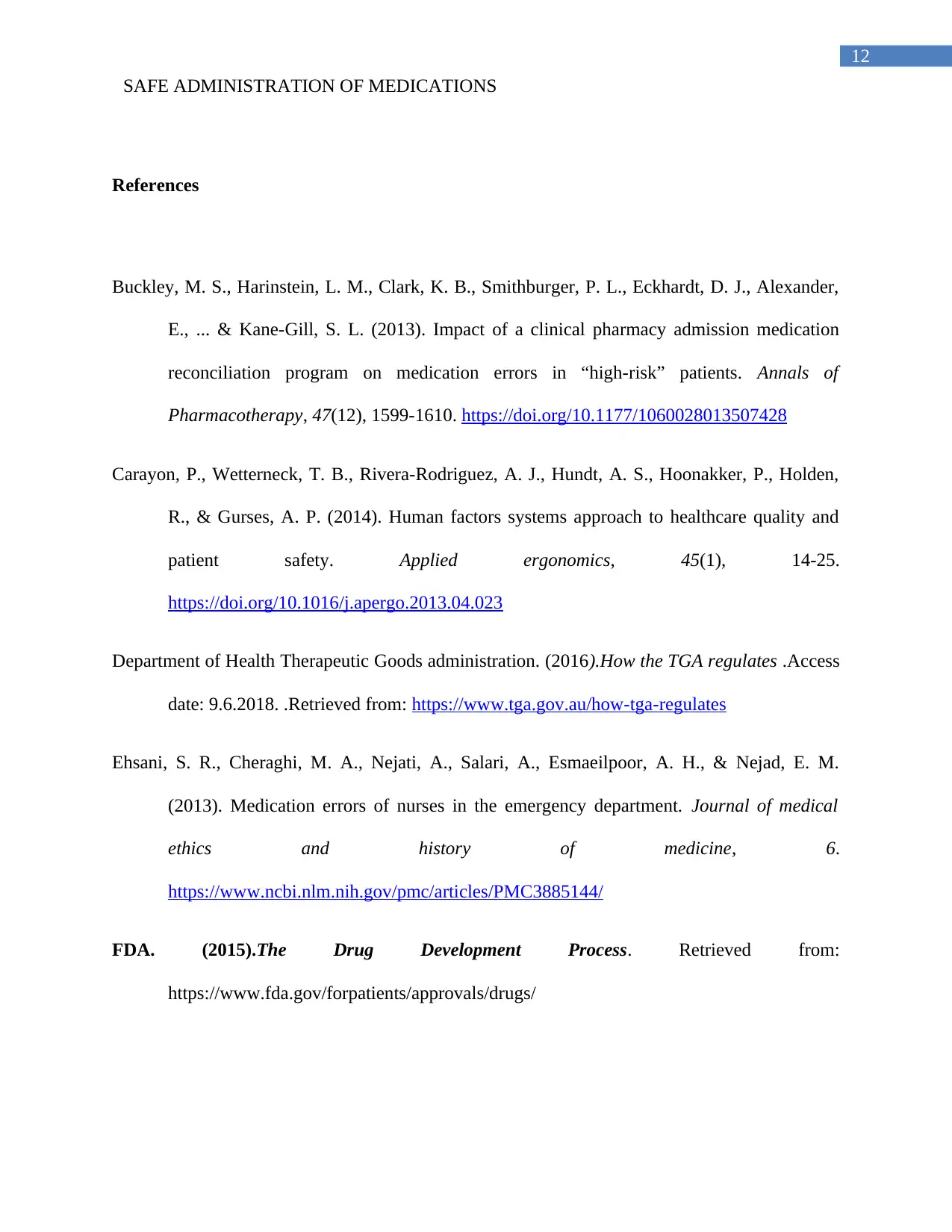
12
SAFE ADMINISTRATION OF MEDICATIONS
References
Buckley, M. S., Harinstein, L. M., Clark, K. B., Smithburger, P. L., Eckhardt, D. J., Alexander,
E., ... & Kane-Gill, S. L. (2013). Impact of a clinical pharmacy admission medication
reconciliation program on medication errors in “high-risk” patients. Annals of
Pharmacotherapy, 47(12), 1599-1610. https://doi.org/10.1177/1060028013507428
Carayon, P., Wetterneck, T. B., Rivera-Rodriguez, A. J., Hundt, A. S., Hoonakker, P., Holden,
R., & Gurses, A. P. (2014). Human factors systems approach to healthcare quality and
patient safety. Applied ergonomics, 45(1), 14-25.
https://doi.org/10.1016/j.apergo.2013.04.023
Department of Health Therapeutic Goods administration. (2016).How the TGA regulates .Access
date: 9.6.2018. .Retrieved from: https://www.tga.gov.au/how-tga-regulates
Ehsani, S. R., Cheraghi, M. A., Nejati, A., Salari, A., Esmaeilpoor, A. H., & Nejad, E. M.
(2013). Medication errors of nurses in the emergency department. Journal of medical
ethics and history of medicine, 6.
https://www.ncbi.nlm.nih.gov/pmc/articles/PMC3885144/
FDA. (2015).The Drug Development Process. Retrieved from:
https://www.fda.gov/forpatients/approvals/drugs/
SAFE ADMINISTRATION OF MEDICATIONS
References
Buckley, M. S., Harinstein, L. M., Clark, K. B., Smithburger, P. L., Eckhardt, D. J., Alexander,
E., ... & Kane-Gill, S. L. (2013). Impact of a clinical pharmacy admission medication
reconciliation program on medication errors in “high-risk” patients. Annals of
Pharmacotherapy, 47(12), 1599-1610. https://doi.org/10.1177/1060028013507428
Carayon, P., Wetterneck, T. B., Rivera-Rodriguez, A. J., Hundt, A. S., Hoonakker, P., Holden,
R., & Gurses, A. P. (2014). Human factors systems approach to healthcare quality and
patient safety. Applied ergonomics, 45(1), 14-25.
https://doi.org/10.1016/j.apergo.2013.04.023
Department of Health Therapeutic Goods administration. (2016).How the TGA regulates .Access
date: 9.6.2018. .Retrieved from: https://www.tga.gov.au/how-tga-regulates
Ehsani, S. R., Cheraghi, M. A., Nejati, A., Salari, A., Esmaeilpoor, A. H., & Nejad, E. M.
(2013). Medication errors of nurses in the emergency department. Journal of medical
ethics and history of medicine, 6.
https://www.ncbi.nlm.nih.gov/pmc/articles/PMC3885144/
FDA. (2015).The Drug Development Process. Retrieved from:
https://www.fda.gov/forpatients/approvals/drugs/
Paraphrase This Document
Need a fresh take? Get an instant paraphrase of this document with our AI Paraphraser
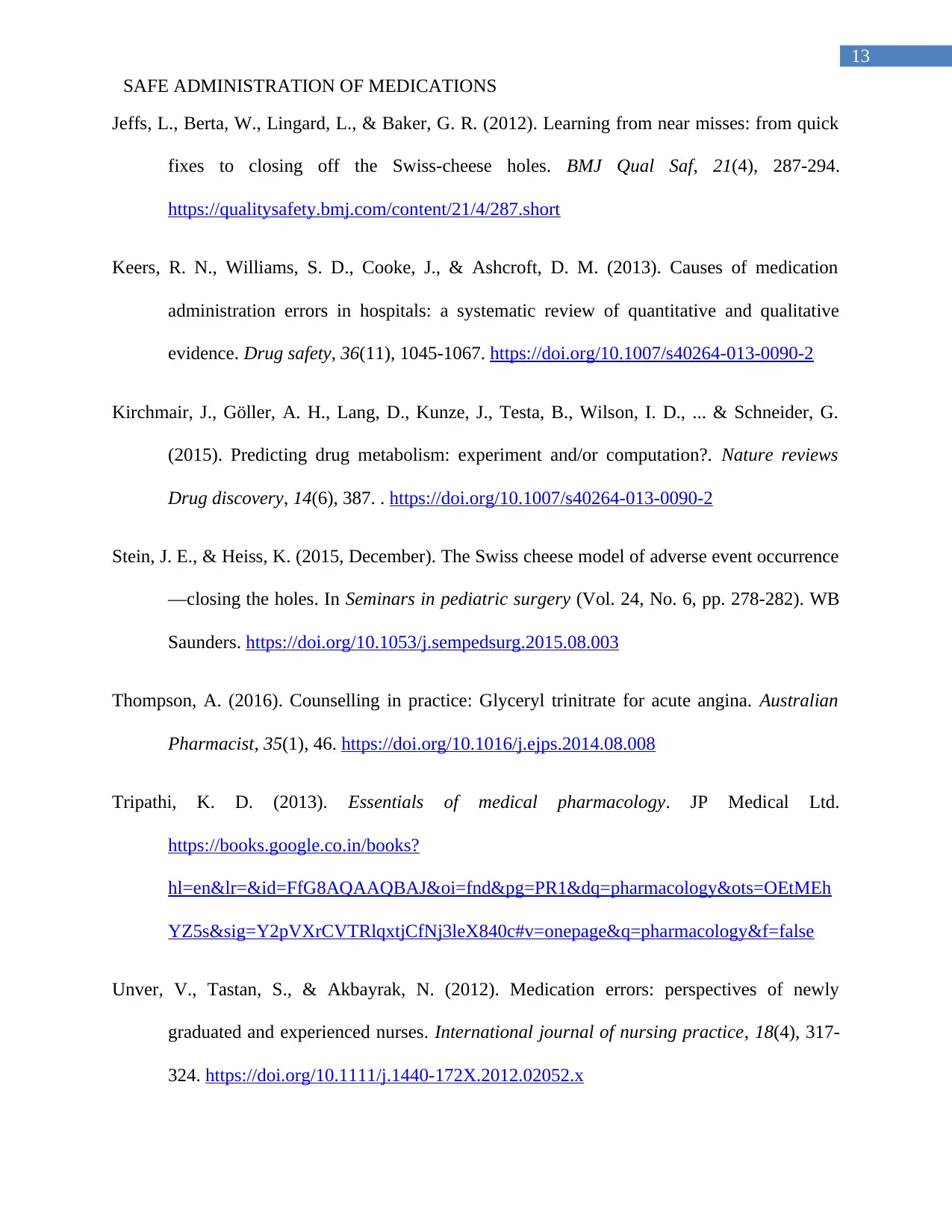
13
SAFE ADMINISTRATION OF MEDICATIONS
Jeffs, L., Berta, W., Lingard, L., & Baker, G. R. (2012). Learning from near misses: from quick
fixes to closing off the Swiss-cheese holes. BMJ Qual Saf, 21(4), 287-294.
https://qualitysafety.bmj.com/content/21/4/287.short
Keers, R. N., Williams, S. D., Cooke, J., & Ashcroft, D. M. (2013). Causes of medication
administration errors in hospitals: a systematic review of quantitative and qualitative
evidence. Drug safety, 36(11), 1045-1067. https://doi.org/10.1007/s40264-013-0090-2
Kirchmair, J., Göller, A. H., Lang, D., Kunze, J., Testa, B., Wilson, I. D., ... & Schneider, G.
(2015). Predicting drug metabolism: experiment and/or computation?. Nature reviews
Drug discovery, 14(6), 387. . https://doi.org/10.1007/s40264-013-0090-2
Stein, J. E., & Heiss, K. (2015, December). The Swiss cheese model of adverse event occurrence
—closing the holes. In Seminars in pediatric surgery (Vol. 24, No. 6, pp. 278-282). WB
Saunders. https://doi.org/10.1053/j.sempedsurg.2015.08.003
Thompson, A. (2016). Counselling in practice: Glyceryl trinitrate for acute angina. Australian
Pharmacist, 35(1), 46. https://doi.org/10.1016/j.ejps.2014.08.008
Tripathi, K. D. (2013). Essentials of medical pharmacology. JP Medical Ltd.
https://books.google.co.in/books?
hl=en&lr=&id=FfG8AQAAQBAJ&oi=fnd&pg=PR1&dq=pharmacology&ots=OEtMEh
YZ5s&sig=Y2pVXrCVTRlqxtjCfNj3leX840c#v=onepage&q=pharmacology&f=false
Unver, V., Tastan, S., & Akbayrak, N. (2012). Medication errors: perspectives of newly
graduated and experienced nurses. International journal of nursing practice, 18(4), 317-
324. https://doi.org/10.1111/j.1440-172X.2012.02052.x
SAFE ADMINISTRATION OF MEDICATIONS
Jeffs, L., Berta, W., Lingard, L., & Baker, G. R. (2012). Learning from near misses: from quick
fixes to closing off the Swiss-cheese holes. BMJ Qual Saf, 21(4), 287-294.
https://qualitysafety.bmj.com/content/21/4/287.short
Keers, R. N., Williams, S. D., Cooke, J., & Ashcroft, D. M. (2013). Causes of medication
administration errors in hospitals: a systematic review of quantitative and qualitative
evidence. Drug safety, 36(11), 1045-1067. https://doi.org/10.1007/s40264-013-0090-2
Kirchmair, J., Göller, A. H., Lang, D., Kunze, J., Testa, B., Wilson, I. D., ... & Schneider, G.
(2015). Predicting drug metabolism: experiment and/or computation?. Nature reviews
Drug discovery, 14(6), 387. . https://doi.org/10.1007/s40264-013-0090-2
Stein, J. E., & Heiss, K. (2015, December). The Swiss cheese model of adverse event occurrence
—closing the holes. In Seminars in pediatric surgery (Vol. 24, No. 6, pp. 278-282). WB
Saunders. https://doi.org/10.1053/j.sempedsurg.2015.08.003
Thompson, A. (2016). Counselling in practice: Glyceryl trinitrate for acute angina. Australian
Pharmacist, 35(1), 46. https://doi.org/10.1016/j.ejps.2014.08.008
Tripathi, K. D. (2013). Essentials of medical pharmacology. JP Medical Ltd.
https://books.google.co.in/books?
hl=en&lr=&id=FfG8AQAAQBAJ&oi=fnd&pg=PR1&dq=pharmacology&ots=OEtMEh
YZ5s&sig=Y2pVXrCVTRlqxtjCfNj3leX840c#v=onepage&q=pharmacology&f=false
Unver, V., Tastan, S., & Akbayrak, N. (2012). Medication errors: perspectives of newly
graduated and experienced nurses. International journal of nursing practice, 18(4), 317-
324. https://doi.org/10.1111/j.1440-172X.2012.02052.x
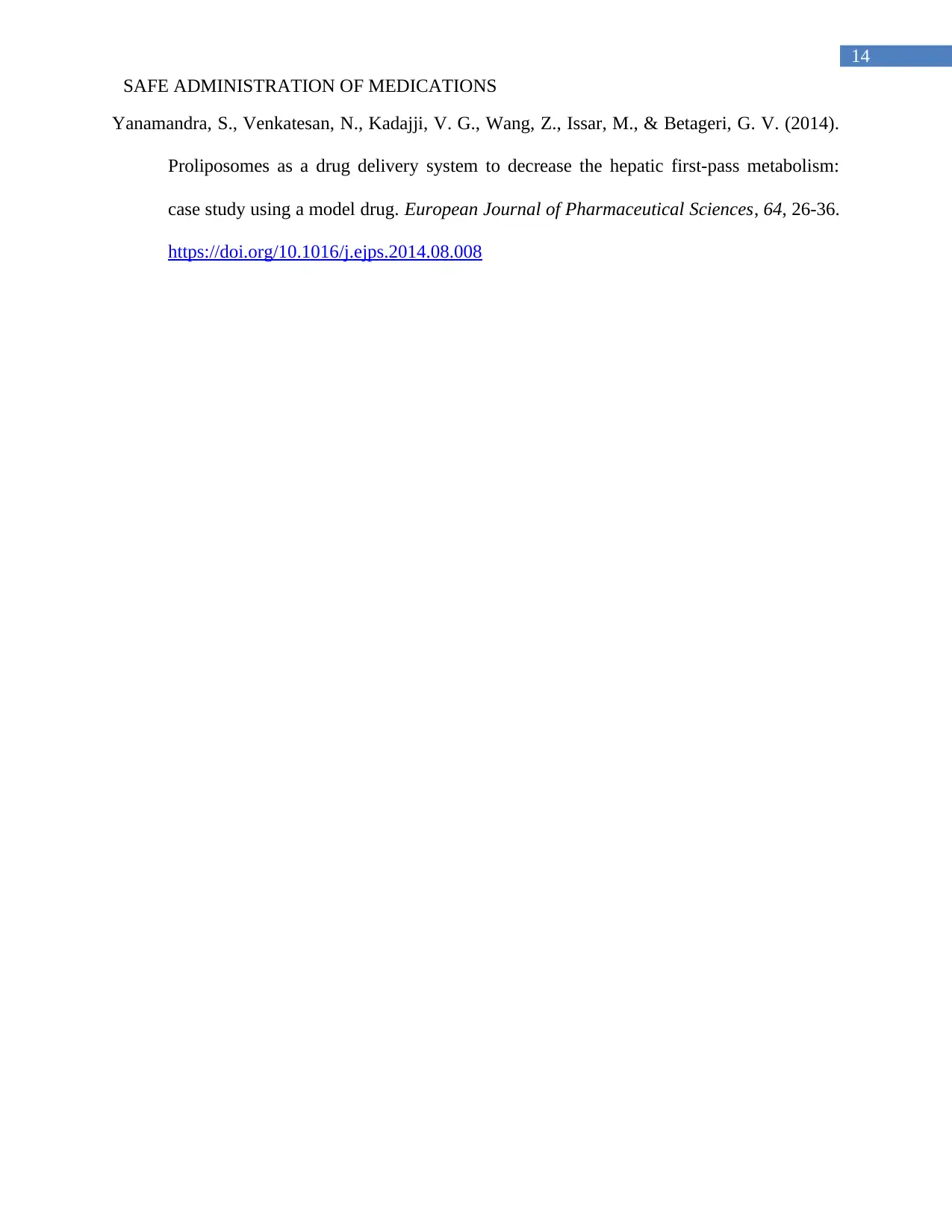
14
SAFE ADMINISTRATION OF MEDICATIONS
Yanamandra, S., Venkatesan, N., Kadajji, V. G., Wang, Z., Issar, M., & Betageri, G. V. (2014).
Proliposomes as a drug delivery system to decrease the hepatic first-pass metabolism:
case study using a model drug. European Journal of Pharmaceutical Sciences, 64, 26-36.
https://doi.org/10.1016/j.ejps.2014.08.008
SAFE ADMINISTRATION OF MEDICATIONS
Yanamandra, S., Venkatesan, N., Kadajji, V. G., Wang, Z., Issar, M., & Betageri, G. V. (2014).
Proliposomes as a drug delivery system to decrease the hepatic first-pass metabolism:
case study using a model drug. European Journal of Pharmaceutical Sciences, 64, 26-36.
https://doi.org/10.1016/j.ejps.2014.08.008
1 out of 15
Related Documents
Your All-in-One AI-Powered Toolkit for Academic Success.
+13062052269
info@desklib.com
Available 24*7 on WhatsApp / Email
![[object Object]](/_next/static/media/star-bottom.7253800d.svg)
Unlock your academic potential
© 2024 | Zucol Services PVT LTD | All rights reserved.





